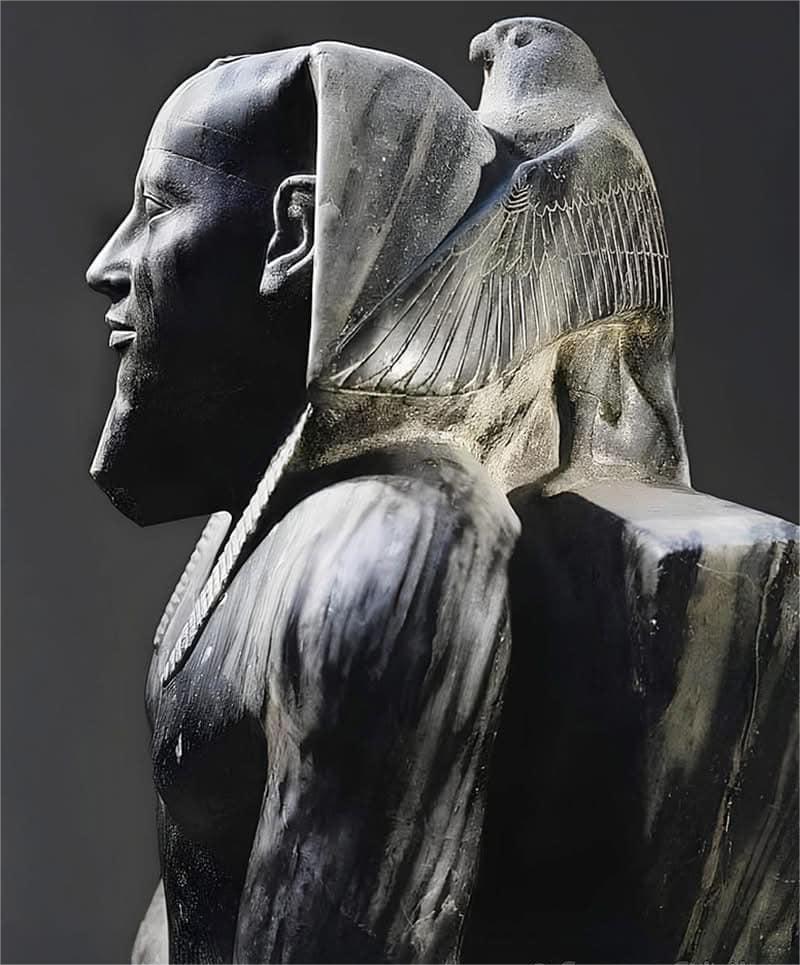Introduction: A Masterpiece of the Old Kingdom
The statue of Pharaoh Khafre, created around 2570 BCE, stands as one of the most remarkable artifacts from ancient Egypt’s Old Kingdom, specifically the 4th Dynasty. This iconic sculpture embodies both the artistic brilliance and the profound symbolism of ancient Egyptian civilization. Carved from durable diorite, it was discovered in Khafre’s Valley Temple near the Great Pyramid and the Sphinx at Giza—a site steeped in historical and cultural significance.

Historical Context: Khafre and the Old Kingdom
Pharaoh Khafre reigned during a time often referred to as the “Age of the Pyramids.” As a ruler, he was responsible for commissioning the second pyramid at Giza, which is slightly smaller than his father Khufu’s Great Pyramid. The discovery of his statue in his Valley Temple highlights its role as part of the broader religious and ceremonial landscape of Giza, which was dedicated to the afterlife and the gods.
The craftsmanship of this statue reflects the peak of artistic achievement during the Old Kingdom. Egyptian sculptors worked tirelessly to create a piece that would convey Khafre’s divine authority, ensuring his eternal legacy.
Artistic Details and Symbolism
One of the most captivating aspects of the statue is its material. Diorite, a rare and incredibly hard stone, was likely imported from Nubia, reflecting the logistical prowess and vast resources of Khafre’s reign. Its use also ensured the sculpture’s longevity, symbolizing the eternal nature of Khafre’s rule.
The statue portrays Khafre seated on a throne, exuding power and composure. His expression is calm and authoritative, symbolizing a ruler in complete control, harmonized with Ma’at, the cosmic order. Behind his head, the falcon god Horus perches protectively, with wings outstretched as though shielding Khafre. This deliberate placement highlights the pharaoh’s divine connection to Horus, who was seen as the protector of Egypt and the living embodiment of the king on earth.
The throne itself is intricately decorated with symbols of unification, such as the intertwined lotus and papyrus plants, representing the unity of Upper and Lower Egypt. Every element of the statue works to reinforce Khafre’s role as both a mortal king and a god on earth.

Theological Significance: Pharaoh as a Divine Figure
In ancient Egyptian theology, the pharaoh was not merely a political leader but also a divine intermediary between the gods and the people. The presence of Horus on the statue is a direct visual representation of this belief. By aligning Khafre with the falcon god, the statue communicates his divine right to rule and his role in maintaining cosmic balance.
The serene expression on Khafre’s face underscores his role as a stabilizing force in a chaotic world. It projects an image of a ruler who is eternal, unchanging, and in harmony with the divine. This was crucial in reinforcing the idea of the pharaoh as the guarantor of Ma’at, a concept central to Egyptian religious and social life.
Craftsmanship and Legacy
The creation of the Khafre statue demonstrates not only the skill of ancient Egyptian artisans but also the significant logistical challenges they overcame. Transporting diorite from distant quarries was a monumental task, requiring coordination and resources on a grand scale. The precision with which the statue was carved—despite the hardness of the material—speaks to the advanced techniques employed by the sculptors of the Old Kingdom.
Today, the statue remains a testament to the ingenuity and vision of ancient Egyptian civilization. Its artistic sophistication and symbolic depth continue to captivate scholars and visitors alike.
Conclusion: Eternal Ruler, Eternal Legacy
The statue of Pharaoh Khafre is more than just a work of art; it is a powerful statement of divinity, authority, and eternal rule. Through its design, materials, and symbolism, it encapsulates the ideals of kingship and cosmic balance that defined ancient Egypt. As we gaze upon this masterpiece, we connect with a civilization that sought to immortalize its leaders and ensure their place within the divine order for eternity.

